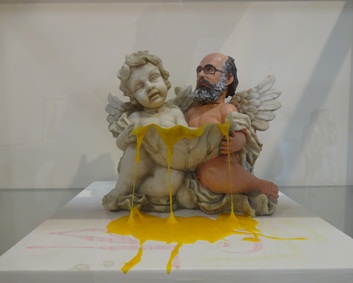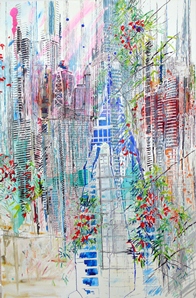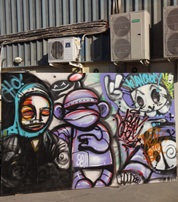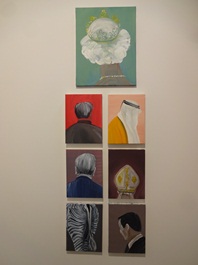 Festivities for the gala opening of the Pullman Dubai Deira City Centre hotel kicked off at 7 p.m. on February 27, 2013. The centerpiece of the ballroom; crowded with cocktail dresses, suits, hijabs, and thwabs; was not the oyster bar carved from ice or endless flutes of Bollinger champagne, or even the speech by the French ambassador. It was the art.
Festivities for the gala opening of the Pullman Dubai Deira City Centre hotel kicked off at 7 p.m. on February 27, 2013. The centerpiece of the ballroom; crowded with cocktail dresses, suits, hijabs, and thwabs; was not the oyster bar carved from ice or endless flutes of Bollinger champagne, or even the speech by the French ambassador. It was the art. 
Three artists were honored for the evening, with their paintings and sculptures spread throughout the room. Karine Roche, a French painter who lives in Abu Dhabi, was the only one able to attend and clearly affected by the recognition of her intriguing blends of urban and floral landscapes--no doubt because of the rarity of any public honoring of artists, but even more so in the UAE, far from global art centers and where breaking the mold is not always encouraged.
Walking around Dubai (or rather, shooting across in the fully automated sky train), there's certainly no shortage of the entrepreneurial spirit, but it's hard to see much of what Western eyes would call the artistic spirit. With the exception of some stunning skyscrapers; like the Burj Khalifa, JW Marriott Hotel, and Burj Al Arab, which demonstrate some truly inspired design; the desert city offers few examples of Bohemianism. 
Nevertheless, like everything in Dubai, things are changing fast. New museums and gallery spaces are starting to pop up around the emirates and the new branch of the Louvre, featuring a translucent webbed dome, is set to open in 2015 in Abu Dhabi.
In Dubai, an enclave of galleries has sprung up in the modestly gritty Al Quoz industrial area, about five miles south of the city center (near Times Square shopping center). The scene buzzes most along Al Serkal Avenue, where exhibition spaces have been carved out of the blue aluminum sided warehouses. Although the area sprung up "organically" according to the galleries owners there, there is nonetheless a feeling of banishment or at least a healthy distance from the mainstream of UAE society.
 But that doesn't seem to bother the gallery owners or participating artists much, nor does the soft prohibition (enter at your own risk) in the UAE of subject matter like politics, religion, and sex -- all key elements, if not inspirations, for much of Western art. However, just as the best sonnets find transcendence within strict rules, so too can the artists, and in Dubai, often they do. (But it does not seem to encourage interviews with journalists unfortunately.)
But that doesn't seem to bother the gallery owners or participating artists much, nor does the soft prohibition (enter at your own risk) in the UAE of subject matter like politics, religion, and sex -- all key elements, if not inspirations, for much of Western art. However, just as the best sonnets find transcendence within strict rules, so too can the artists, and in Dubai, often they do. (But it does not seem to encourage interviews with journalists unfortunately.)
Belgian-born Isabelle van den Eynde runs one of the galleries (under her name) and considers her work almost missionary. The inspiration came when traveling in Iran, where she met so many stifled artists, that she felt compelled to give voice to, sometimes carrying their artworks across the restricted borders to give them first-time exposure. Ever since, she's been working hard to offer a platform for emergent artists from the region, including Rokni and Ramin Haerizadeh, Hesam Rahmanian, Ahmad Amin Nazar and Hassan Sharif, an Emirate artist.
Farther down the "avenue" at La Galerie Nationale, owner Guillaume Cuiry faces another set of challenges. The inspiration for his gallery came during a trip in 2005, when the buoyancy and energy of the UAE cities impressed. No one, he realized was representing the cutting edge of 20th century design in the city of cutting edge 21st century design. 
However, Cuiry decided to wait for the market to mature (and pass the economic crisis). It was the launch of Art Dubai, a now annual international art fair, in 2007, and the creation of arts venues in the Dubai International Finance Center and Al Serkal Avenue, that convinced him it was time. "With a concentration of galleries and diversified art offers, Al Serkal Avenue is the only space in Middle East where visitors can spend a peaceful day visiting galleries as experts or discovering art in family."
For Cuiry and others dealing art in the region, some of the challenge of the business is navigating an often completely different perspective of art appreciation. Avant-garde Parisian cinema sconces from the 1940s by Raymond Subes may simply lack local aesthetics or material to engage the Middle Eastern eye. Indeed, many regional buyers employ professional art advisers and interior architects to help determine the "value" for them. Happily, enthusiasm is building and attracting increasing numbers of people to the gallery. Today, Cuiry gauges the balance of locals to expats at an even 50-50. 
Back at the Pullman soiree, Roche expresses other frustrations with pursuing art in UAE. "Most of the local inhabitants are simply not really interested by contemporary art and the access to the local contemporary art scene is often not easy. It takes effort to go and see an art exhibition." Luckily she is supported by the French Alliance and French Institute, two organizations working to build cultural bridges between UAE and France, and still seems enthusiastic about the potential of the burgeoning art scene. "10 years ago there was almost nothing and in two years there will be one of the best museums in the world [the Louvre]! It should be something very astonishing to witness how people will evolve surrounded by art."
For now, her paintings are finding a new audience at the Pullman hotel as part of the brand's new art collection, As Xavier Louyot, senior vice president of Global Marketing of Pullman explains, the collection "will explore an essential aspect of our times: the re-emergence of cultural identities in a modern world marked by universality and cultural mixing."
But the Pullman may be contributing more than it realizes. Art can often transcend mere exploration and provide a hub or junction point where seemingly disparate cultures find a vision of harmony and proof of their shared humanity, sometimes when little else does. If the pen is indeed mightier than the sword, how much more so the brush and chisel.
All photos are by Mike Dunphy, except Karin Roche's painting, given with permission from the artist.